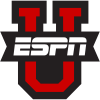ESPN U
ESPNU is an American digital cable and satellite sports television channel that is owned by ESPN Inc., a joint venture between the Disney Media Networks division of The Walt Disney Company (which owns a controlling 80% stake) and the Hearst Communications (which owns the remaining 20%). The channel is primarily dedicated to coverage of college athletics, and is also used as an additional outlet for general ESPN programming. ESPNU is based alongside its sister networks at ESPN’s headquarters in Bristol, Connecticut.
As of September 2018, ESPNU is available to approximately 62.7 million pay television households (68% of households with cable TV) in the United States.[1]
The network was launched on March 4, 2005, with its first broadcast originating from the site of Gallagher-Iba Arena on the Oklahoma State University campus in Stillwater, Oklahoma. The network’s first live event was a semifinal game of the Ohio Valley Conference men’s basketball tournament between Southeast Missouri State University and Eastern Kentucky University. The network was launched as a response to rival College Sports Television (CSTV) (now CBS Sports Network). ESPN was also being investigated by the U.S. Justice Department on allegations of “warehousing” collegiate sporting events from certain conferences, or signing a deal with a conference for all their games, but only televising a small number and not allowing the conference to make other arrangements for television broadcasts.
ESPN and XOS Technologies entered into a partnership for college athletics websites to compete directly with CSTV’s growing internet presence. On August 28, 2006, ESPNU launched a new SportsCenter spin-off focusing entirely on college sports. The program, SportsCenterU, was originally scheduled to be broadcast from ESPN’s headquarters in Bristol, Connecticut, however ESPN instead chose to originate the show from Charlotte. Mike Hall was the program’s lead anchor until August 2007, when he left for the new Big Ten Network. He was replaced by Mike Gleason and Lowell Galindo. The two are joined on-set by color commentators that vary depending on the sports season.
The same day as SportsCenterU’s debut, ESPNU launched the website ESPNU.com. The site included live streaming of college sports events, a multi-media player dedicated to college sports, podcasts and ESPN Motion clips of studio programming from the ESPNU television network.
ESPNU expanded its live programming to water polo by broadcasting its first-ever water polo match between the women’s teams of Princeton University and Bucknell University on March 28, 2009, from DeNunzio Pool in Princeton, New Jersey.
In addition to its collegiate sports coverage, ESPNU has simulcast ESPN Radio’s midday program over its airwaves since 2008, with the exception of a brief period between 2011 and 2012. The program airing for the majority of that time was The Herd with Colin Cowherd, which has since moved to Fox Sports Radio and is simulcast on Fox Sports 1. Following Cowherd’s departure and several weeks of guest hosts taking over the timeslot, The Dan Le Batard Show with Stugotz became the permanent replacement for The Herd.
On April 26, 2017, as part of a larger series of company-wide cuts, it was announced that ESPNU’s studio operations would be re-located from Charlotte to ESPN’s main headquarters in Bristol, Connecticut. Less than 10 employees were laid off as part of the cuts. SEC Network and ESPN Events continue to operate out of Charlotte.[2]
On August 8, 2017, ESPNU aired a marathon of lesser-known and unconventional non-college sports as “ESPN 8: The Ocho”—an homage to a fictitious eighth ESPN channel portrayed in the film DodgeBall: A True Underdog Story, which aired events that were “almost a sport”.[3][4] The stunt was reprised the following year on ESPN2.[5]
On August 31, 2017, as part of an extension of ESPN’s agreements with the service, Sirius XM’s channel College Sports Nation was relaunched as ESPNU Radio. The channel carries audio simulcasts of ESPN college sports studio programming, as well as other programs and event coverage.[6][7]


